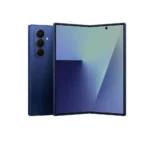Hon Hai Research Institute (HHRI), a branch of Foxconn (Hon Hai Precision Industry), has made significant strides in advancing spatial computing by developing a groundbreaking depth sensing and facial recognition system. This innovative technology, led by the collaborative efforts of Guo Haozhong from the Institute of Semiconductors and NYCU’s chair professor, along with Dr. Hong Yuheng’s research team and assistant professor Huang Yaowei’s team from NYCU, has achieved recognition by being featured on the cover of the prestigious journal “Nano Letters.”
The published paper, “Metasurface- and PCSEL-Based Structured Light for Monocular Depth Perception and Facial Recognition,” highlights the system’s use of cutting-edge nano-optical technology. It integrates a single photonic crystal surface-emitting laser (PCSEL) with a super-interface hologram, projecting up to 45,700 infrared structured light spots, and offering a wide field of view of 158°. This leap in technology provides a substantial enhancement over traditional systems, allowing a significant reduction in size, an increase in the efficiency of light spots, and a broader field of view without the need for additional lens systems.
The research has not only been celebrated in the academic sphere but has also garnered the attention of the American Chemical Society, which conducted a highlight news interview and published related reports. This acknowledgment underscores the system’s potential to redefine facial recognition technology and its adaptability to the evolving demands of spatial computing.
Hon Hai’s innovative approach reduces the size of the depth sensing system to mere microns, surpassing the conventional dot projector limitations and paving the way for more compact, energy-efficient solutions in mobile phones, spatial computing, and wearable technologies. This technological advancement is poised to become a cornerstone in the industry, leading the way toward a new era of high-efficiency, low-power, and miniaturized spatial computing solutions.



